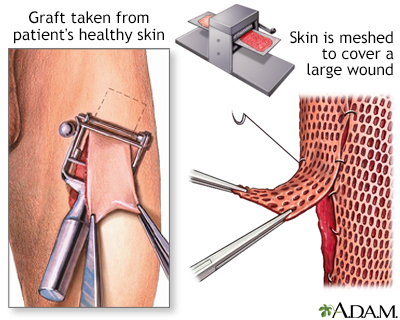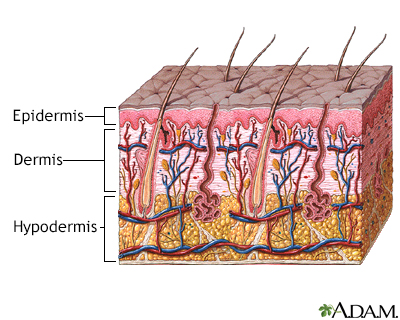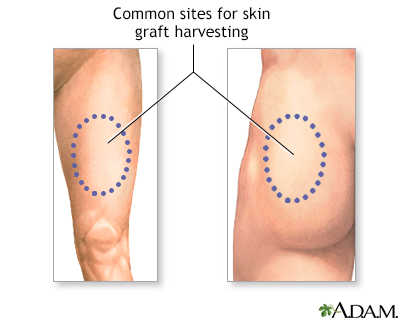How Long After Skin Graft Can I Wear Makeup
Skin graft
Skin transplant; Skin autografting; FTSG; STSG; Split thickness skin graft; Full thickness peel graft
A pare graft is a patch of skin that is removed by surgery from one area of the body and transplanted, or fastened, to another area.

A skin graft is a surgical procedure in which a piece of peel is transplanted from i area to another. Ofttimes skin will be taken from unaffected areas on the injured person and used to cover a defect, frequently a burn. If the surface area of the skin defect is especially large, the harvested skin may be meshed to stretch information technology into a larger patch. If the defect involves a great loss of tissue, a full thickness graft, a flap of skin with underlying muscle and blood vessles, may be required. Taking the graft from the injured person makes rejection of the tissue unlikely.

The pare is the largest organ of the body. The skin and its derivatives (hair, nails, sweat and oil glands) make up the integumentary arrangement. Ane of the primary functions of the skin is protection. Information technology protects the trunk from external factors such as leaner, chemicals, and temperature. The skin contains secretions that can kill leaner and the pigment melanin provides a chemic pigment defence force confronting ultraviolet lite that tin can impairment skin cells. Another important function of the skin is trunk temperature regulation. When the pare is exposed to a common cold temperature, the blood vessels in the dermis constrict. This allows the blood which is warm, to featherbed the pare. The peel then becomes the temperature of the cold information technology is exposed to. Torso heat is conserved since the blood vessels are not diverting estrus to the skin anymore. Amongst its many functions the skin is an incredible organ always protecting the body from external agents.

The pare covers the entire body, and acts as a protective barrier. Peel grafts may exist recommended for extensive wounds, burns, or specific surgeries that may require skin grafts for healing to occur. The most common sites of harvest for skin grafts are the buttocks and inner thigh, areas which are commonly hidden and therefore cosmetically less of import.
Description
This surgery is ordinarily done while y'all are nether general anesthesia. That means you volition exist comatose and pain-free.
Good for you peel is taken from a place on your body chosen the donor site. Most people who are having a skin graft accept a dissever-thickness skin graft. This takes the two meridian layers of skin from the donor site (the epidermis) and the layer under the epidermis (the dermis).
The donor site can be whatever expanse of the body. About times, it is an expanse that is hidden past clothes, such as the buttock or inner thigh.
The graft is carefully spread on the blank area where it is being transplanted. It is held in identify either by gentle force per unit area from a well-padded dressing that covers it, or by staples or a few minor stitches. The donor-site surface area is covered with a sterile dressing for 3 to 5 days.
People with deeper tissue loss may demand a full-thickness skin graft. This requires the entire thickness of skin from the donor site, not only the top two layers.
A full-thickness pare graft is a more complicated process. Mutual donor sites for full-thickness peel grafts include the chest wall, neck, back, or abdominal wall.
Why the Procedure Is Performed
Peel grafts may be recommended for:
- Areas where at that place has been infection that caused a big amount of pare loss
- Burns
- Corrective reasons or reconstructive surgeries where there has been skin damage or skin loss
- Peel cancer surgery
- Surgeries that need pare grafts to heal
- Venous ulcers, pressure level ulcers, or diabetic ulcers that exercise non heal
- Very large wounds
- A wound that the surgeon has non been able to close properly
Full-thickness grafts are done when a lot of tissue is lost. This tin can happen with open fractures of the lower leg, or after severe infections.
Risks
Risks for anesthesia and surgery in general are:
- Allergic reactions to medicines
- Problems with animate
- Haemorrhage, blood clots, or infection
Risks for this surgery are:
- Haemorrhage
- Chronic pain (rarely)
- Infection
- Loss of grafted peel (the graft not healing, or the graft healing slowly)
- Reduced or lost skin sensation, or increased sensitivity
- Scarring
- Peel discoloration
- Uneven skin surface
Before the Process
Tell your surgeon or nurse:
- What medicines yous are taking, fifty-fifty drugs or herbs you bought without a prescription.
- If you take been drinking a lot of alcohol.
During the days before surgery:
- Y'all may exist asked to stop taking medicines that make it hard for your blood to clot. These include aspirin, ibuprofen, warfarin (Coumadin), and others.
- Inquire your surgeon which drugs you should still take on the day of your surgery.
- If you smoke, endeavour to cease. Smoking increases your adventure of bug such every bit dull healing. Ask your health care provider for aid quitting.
On the 24-hour interval of the surgery:
- Follow instructions about when to stop eating and drinking.
- Take the drugs your surgeon told you to have with a small sip of water.
After the Procedure
Y'all should recover quickly after split-thickness skin grafting. Full-thickness grafts demand a longer recovery time. If you received this kind of graft, y'all may need to stay in the infirmary for recovery.
After you are discharged from the hospital, follow instructions on how to care for your skin graft, including:
- Wearing a dressing for i to 2 weeks. Inquire your provider how you should care for the dressing, such equally protecting it from getting moisture.
- Protecting the graft from trauma for 3 to 4 weeks. This includes avoiding being hitting or doing any exercise that might injure or dislodge the graft.
- Getting physical therapy, if your surgeon recommends information technology.
Outlook (Prognosis)
Most skin grafts are successful, but some do not heal well. You lot may need a second graft.
References
Padilla PL, Khoo KH, Ho T, Cole EL, Sirvent RZ, Phillips LG. Plastic surgery. In: Townsend CM Jr, Beauchamp RD, Evers BM, Mattox KL, eds. Sabiston Textbook of Surgery. 21st ed. St Louis, MO: Elsevier; 2022:chap 69.
Ratner D, Nayyar PM. Grafts, In: Bolognia JL, Schaffer JV, Cerroni Fifty, eds. Dermatology. 4th ed. Philadelphia, PA: Elsevier; 2018:chap 148.
Scherer-Pietramaggiori SS, Pietramaggiori Thou, Orgill DP. Peel graft. In: Gurtner GC, Neligan PC, eds. Plastic Surgery, Volume 1: Principles. 4th ed. Philadelphia, PA: Elsevier; 2018:chap 15.
Version Info
Last reviewed on: 3/ten/2021
Reviewed past: Tang Ho, MD, Associate Professor, Division of Facial Plastic and Reconstructive Surgery, Department of Otolaryngology – Head and Neck Surgery, The Academy of Texas Medical Schoolhouse at Houston, Houston, TX. Also reviewed by David Zieve, Physician, MHA, Medical Director, Brenda Conaway, Editorial Managing director, and the A.D.A.One thousand. Editorial team.

Source: https://www.mountsinai.org/health-library/surgery/skin-graft
Posted by: hendricksonfalmyst64.blogspot.com

0 Response to "How Long After Skin Graft Can I Wear Makeup"
Post a Comment